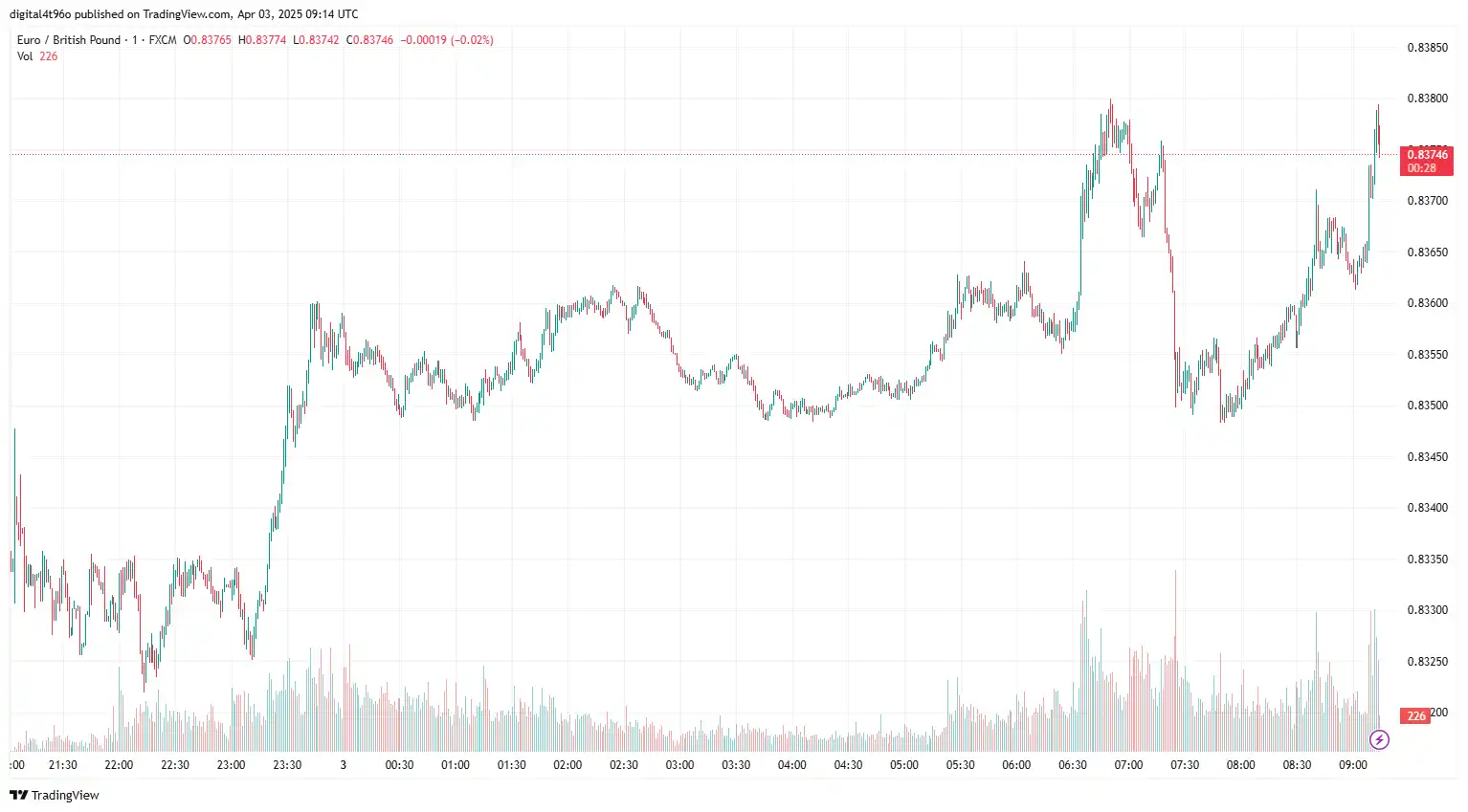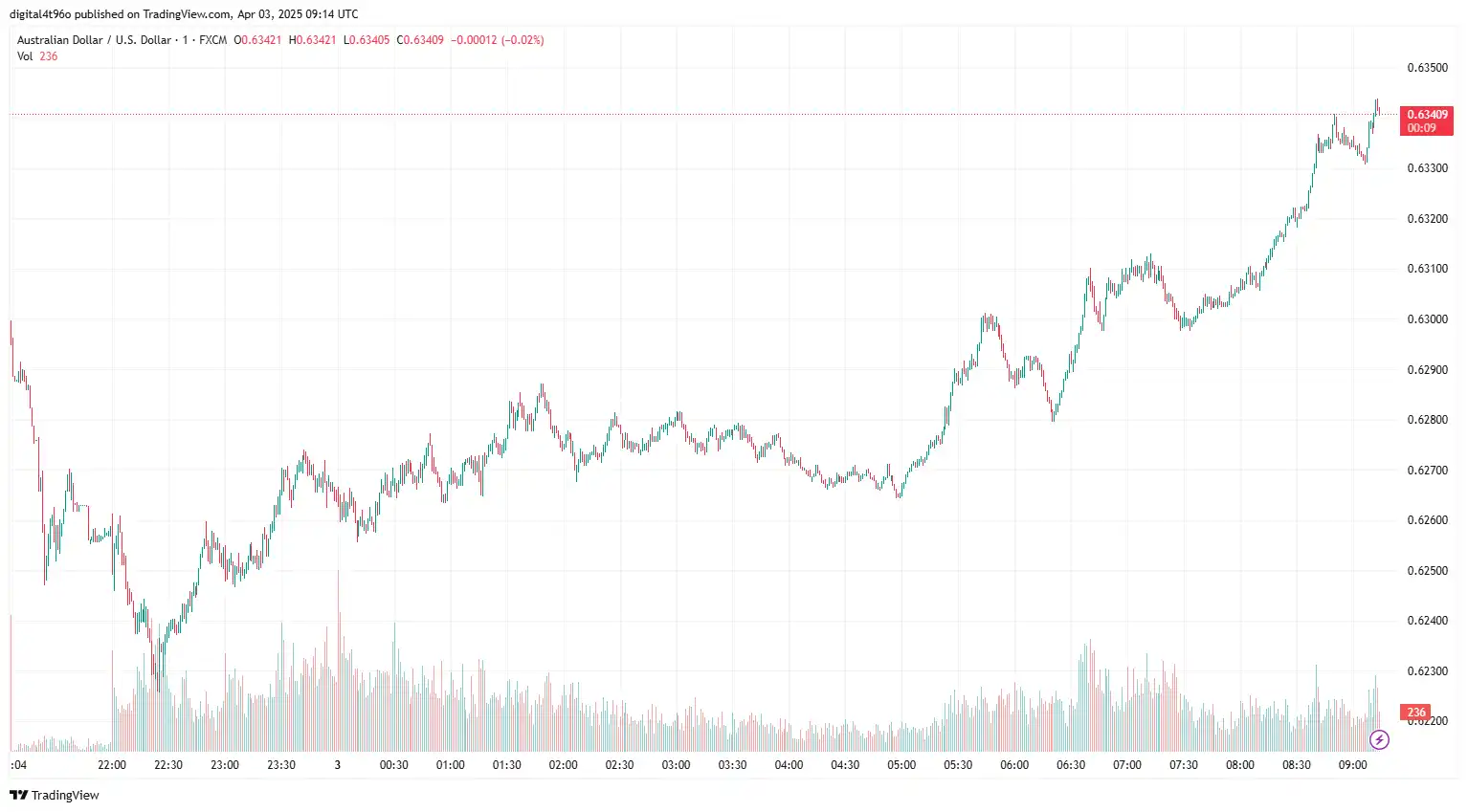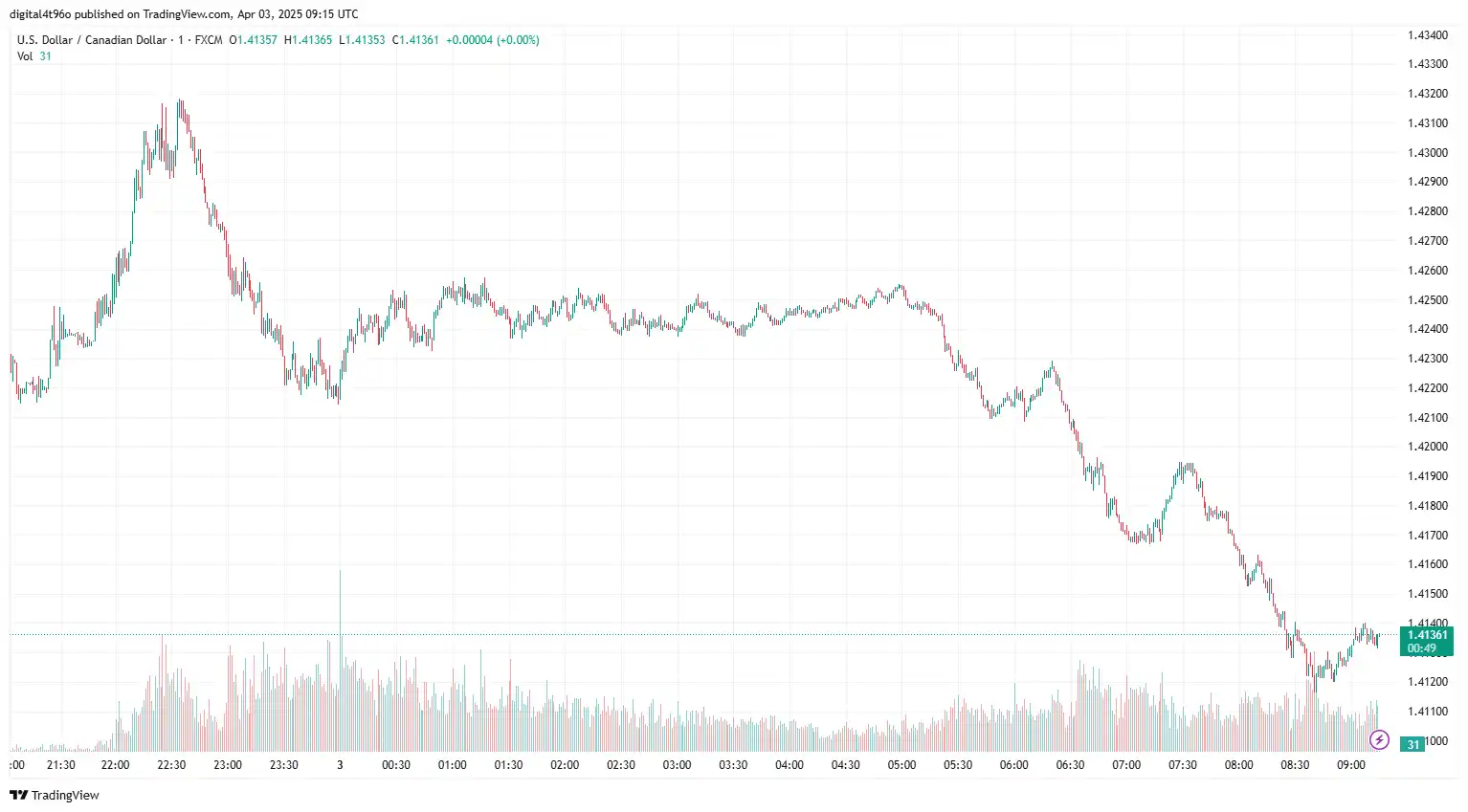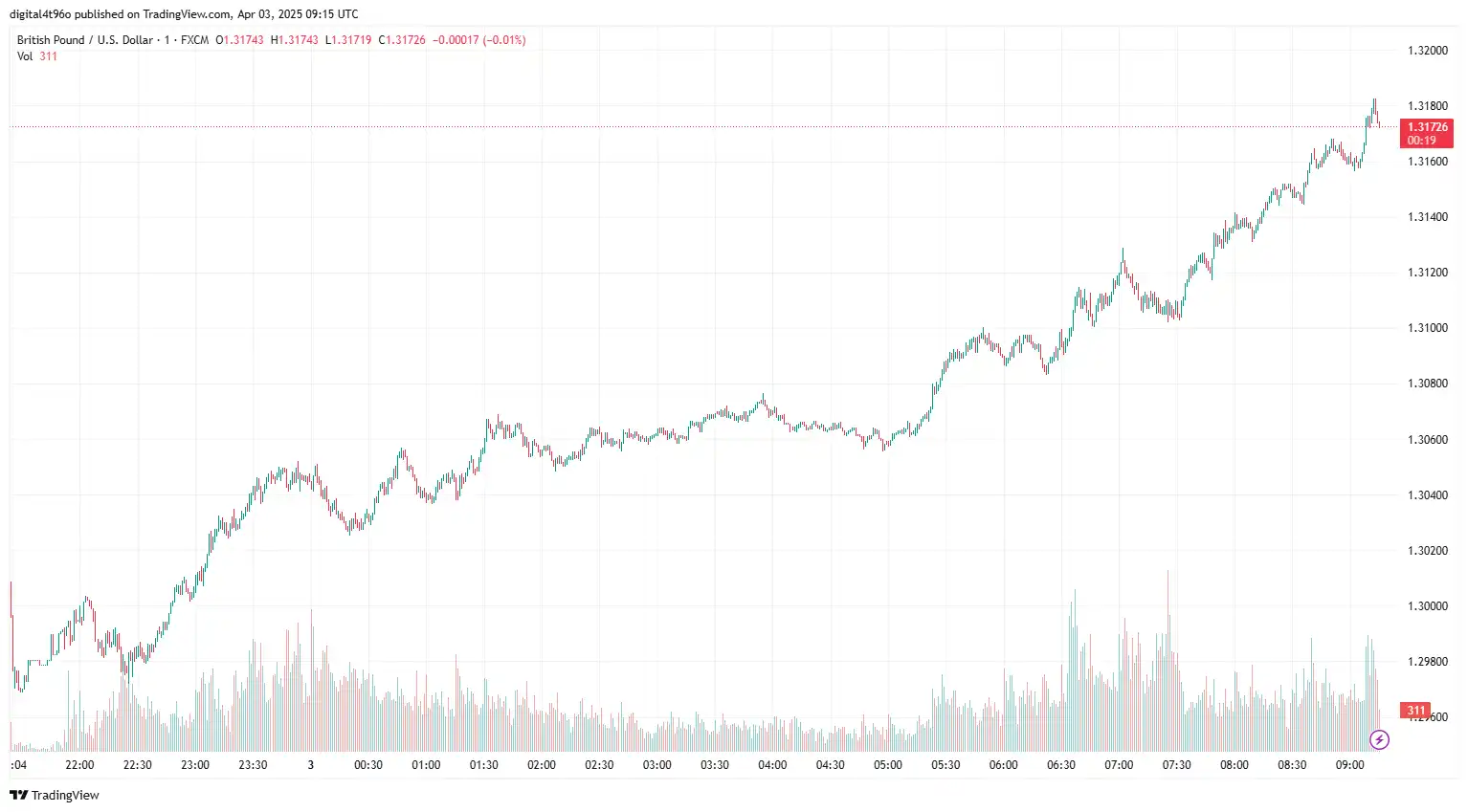EUR/GBP Buoyed Following Trump Tariff Announcement
EUR/GBP gained ground to 0.8368, following discouraging market sentiment after US President Donald Trump announced reciprocal tariffs, raising concerns about slowing global economic growth. Trump intends to implement a 20% tariff on goods from the EU and increase duties on several major trading partners. These tariffs are set to take effect on April 9. Ursula von der Leyen, President of the European Commission, criticised Trump's tariff actions on EU goods and pledged a response.
On the data front, Services Purchasing Managers' Index (PMI) data from the Eurozone reflected mixed performance. The HCOB Spain Services PMI decreased to 54.7 in March from 56.2 in February, falling short of the expected 55.5, indicating ongoing expansion, albeit slower. Meanwhile, the HCOB Italy Services PMI dipped to 52.0 in March from 53.0 in February, below the forecast of 52.5, marking the fourth consecutive month of expansion in the services sector. In contrast, the HCOB France Services PMI increased to 47.9 in March from 45.3 in February, exceeding the anticipated 46.6. While the industry continues to contract for the seventh straight month, the reduced rate of decline hints at a potential stabilisation. Lastly, the HCOB Germany Services PMI slightly decreased to 50.9 in March from 51.1 in February, remaining above the preliminary estimate of 50.2. The HCOB Eurozone Services PMI rose to 51.0 in March, up from 50.6 in February, and exceeded the preliminary estimate of 50.4. Meanwhile, the HCOB Eurozone Composite PMI climbed to 50.9 in March, an increase from 50.2 in February, also surpassing the preliminary estimate of 50.4, signalling modest expansion in private sector activity. Today, the European Central Bank (ECB) will publish the minutes from its recent policy meeting. If investors discover indications that more policymakers believe Eurozone interest rates are approaching a neutral level, this could generate new demand for the euro.
Sterling initially wobbled after the announcement of a 10% tariff on all products entering the US, alongside other specific levies. This news, particularly affecting the United Kingdom, dampened market expectations for an exemption from Trump's extensive tariff plans. In March, the S&P Global/CIPS UK Services Purchasing Managers' Index (PMI) rose to 53.2, up from 51.0 in February, exceeding the anticipated 51.2. Additionally, the S&P Global UK Composite PMI climbed to 52.0 in March 2025, compared to 50.5 in February, also surpassing market predictions of 50.3. This indicates modest growth in the private sector, marking the highest reading since September.
Broader market sentiment around the European Central Bank (ECB) Monetary Policy Meeting accounts and service Purchasing Managers' Index (PMI) figures from both regions will guide the EUR/GBP exchange rate.

AUD/USD Climbs on Upbeat Chinese PMI Data
AUD/USD increased to around 0.6302, as stronger Chinese economic data supported the Aussie. The latest data from Caixin revealed that China's Services Purchasing Managers' Index (PMI) rose to 51.9 in March, up from 51.4 in February and surpassing market expectations of 51.6. On the domestic front, Australia's trade surplus narrowed to AUD 2.97 billion in February, falling short of the expected AUD 5.6 billion and down from a revised AUD 5.16 billion in January, according to the Australian Bureau of Statistics. A closer look at the data shows that exports declined by 3.6% month-on-month in February, compared to a revised 0.8% increase in January. Meanwhile, imports rose by 1.6% in February, reversing a 4.0% decline recorded in the previous month. On Tuesday, RBA Assistant Governor Christopher Kent shared updates regarding minor repurchase agreement (repo) operations changes. He clarified that these adjustments do not indicate a change in monetary policy. Starting April 9, the RBA will increase the pricing on new open market operation (OMO) repos by five basis points, elevating them to 10 basis points above the cash rate target. Additionally, a new seven-day term will be introduced, complementing the existing 28-day term.
On the policy front, the Reserve Bank of Australia (RBA) decided to maintain the Official Cash Rate at 4.1% during its April meeting, matching expectations. In its announcement, the central bank adopted a cautious approach, reaffirming its commitment to sustainably returning inflation to target levels. While it recognised the recent decline in underlying inflation as positive, it also pointed out that policy remains restrictive, keeping a possible rate cut in May on the table. During the post-meeting press conference, Governor Michele Bullock stated that a rate cut had not been discussed, and the Board had not decided in May. She emphasised, "We need to be cautious not to rush our policy decisions," and acknowledged that, while confidence in inflation is gradually improving, it is "not quite there yet," indicating that further data is necessary before making any moves.
On the global front, the cautious market mood following US President Donald Trump's announcement of global reciprocal tariffs could limit the upside of risk-sensitive AUD. On Wednesday, the announcement of higher tariffs affected China significantly, with increased rates applied to specific countries deemed to engage in unfair trade. As a result, China will encounter an extra 34% tariff in addition to the duties already imposed. Before this, Chinese goods were already subject to a 20% tariff introduced in March 2025. Consequently, the overall tariff on Chinese imports will reach 54%, set to take effect on April 9, 2025.
On the other hand, rising concerns over the potential economic slowdown following softer economic data and growing uncertainty around tariff-related trade risks undermined the greenback. US private-sector hiring accelerated in March, with employers adding 155,000 jobs—well above the 105,000 forecast by economists, according to the latest ADP report. The figure also marks a sharp improvement from February's revised total of 84,000, up from the initially reported 77,000.
In the upcoming sessions, the US economic docket—featuring US weekly Initial Jobless Claims, the final S&P Global Services PMI, and the ISM Services PMI—and any development on trade tensions between the US and China could influence the AUD/USD exchange rate.

USD/CAD Declines on Tariff Relief
USD/CAD weakened to 1.4118 as a positive shift in market sentiment following Trump's announcement turned market attention to the CAD, raising its demand. On April 2, 2025, President Donald Trump revealed significant tariff increases, implementing a standard 10% charge on all US imports along with higher tariffs aimed at specific countries. Canada and Mexico are exempt from these new tariffs, adhering to existing USMCA agreements. However, the 10% tariff for these nations will only be applied once the previously imposed 25% tariffs—initiated due to concerns regarding drug trafficking and border security—are removed or suspended. This exemption initially raised investor confidence in Canada's economic prospects, leading to a stronger Canadian dollar (CAD) against the US dollar. Nevertheless, Canadian Prime Minister Mark Carney reacted decisively, promising to implement retaliatory measures, intensifying fears of escalating trade tensions. Additionally, a decline in crude oil prices, resulting from worries that a global trade conflict could reduce demand, has exerted downward pressure on the oil-sensitive Canadian dollar. Given that Canada is the largest supplier of crude oil to the US, falling oil prices generally adversely affect the CAD.
On the other hand, concerns about the consequences of a mounting global trade conflict and a series of disappointing US economic data heightened fears of a significant economic downturn in the US, contributing to a broad decline in the USD. On Wednesday, Fed Governor Adriana Kugler commented that escalating tariffs will increase inflationary pressures within the US. She also noted that she agrees with the current policy outlook, maintaining the interest rate steady as long as these upside risks to inflation persist. US private-sector hiring accelerated in March, with employers adding 155,000 jobs—well above the 105,000 forecast by economists, according to the latest ADP report. The figure also represents a sharp improvement from February's revised total of 84,000, up from the initially reported 77,000.
In the upcoming sessions, investors will focus on labour market data from both the USA and Canada, featuring the Unemployment Rate, Average Hourly Earnings, and non-farm Employment Change to give fresh impetus to the USD/CAD exchange rate.

GBP/USD Rises as Trump Tariffs Stoke Recession Fears
GBP/USD climbed to 1.3146 as the US Dollar fell sharply after President Donald Trump announced tariffs on trading partners that exceeded expectations. On Wednesday, Trump announced a 10% baseline tariff on all imports to the United States (US), along with higher duties on several of the nation's major trading partners. During his recent interview, Stephen Miran, Chair of the US Council of Economic Advisers, acknowledged that Trump's protectionist policies might result in "short-term bumps" for the economy. Nevertheless, he emphasised that the president aims for a "long-term economic transition," enhancing the "durability, sustainability, and fairness" of the American economy globally. However, concerns over the consequences of an escalating global trade conflict, coupled with a string of disappointing US economic indicators, have intensified fears of a potential economic downturn in the United States, contributing to broad weakness in the US dollar. On Wednesday, Federal Reserve Governor Adriana Kugler stated that rising tariffs are likely to increase inflationary pressures domestically. She affirmed her support for the Fed's current policy stance, suggesting interest rates should remain unchanged as long as upside risks to inflation persist. Meanwhile, US private-sector hiring picked up momentum in March. According to the latest ADP report, employers added 155,000 jobs—significantly above the 105,000 projected by economists. This figure also marks a notable recovery from February's revised total of 84,000, previously estimated at 77,000.
Sterling trades with a cautious tone as markets react to the latest trade developments. While US President Donald Trump imposed reciprocal tariffs on several major trading partners, the United Kingdom received the lowest rate—just 10%—marking the minimal level on the new tariff chart. Despite this, the British Pound (GBP) remains underpinned by expectations that the Bank of England (BoE) will adopt a more gradual approach to monetary easing compared to its global counterparts, including the Federal Reserve. On the data front, UK economic indicators offered modest encouragement. In March, the S&P Global/CIPS UK Services PMI rose to 53.2 from 51.0 in February, exceeding forecasts of 51.2. The Composite PMI also advanced to 52.0, up from 50.5 previously and above the expected 50.3—signalling the strongest expansion in private sector activity since September.
Investors will pay attention to the US S&P Global and the ISM Services Purchasing Managers' Index (PMI) data for March, as well as the global market mood, for guidance on the GBP/USD exchange rate.

Stay Ahead in the Currency Game
Whether you're a daily FX trader or handle international transactions regularly, our 'Currency Pulse' newsletter delivers the news you need to make more informed decisions. Receive concise updates and in-depth insights directly in your LinkedIn feed.
Subscribe to 'Currency Pulse' now and never miss a beat in the currency markets!
Ready to act on today’s insights? Get a free quote or give us a call on: +44 (0)20 7740 0000 to connect with a dedicated portfolio manager for tailored support.
Important: This blog is for informational purposes only and should not be considered financial advice. Currency Solutions does not consider individual investment goals, financial circumstances, or specific requirements of readers. We do not endorse or recommend any particular financial strategies or products discussed. Currency Solutions provides this content as is, without any guarantees of completeness, accuracy, or timeliness.




